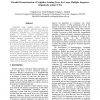322 search results - page 14 / 65 » A new approach to sequence comparison: normalized sequence a... |
RECOMB
2002
Springer
14 years 7 months ago
2002
Springer
A recent idea for determining the three-dimensional structure of a protein uses antibody recognition of surface structure and random peptide libraries to map antibody epitope comb...
CSB
2003
IEEE
14 years 24 days ago
2003
IEEE
A new and essentially simple method to reconstruct prokaryotic phylogenetic trees from their complete genome data without using sequence alignment is proposed. It is based on the ...
ICASSP
2010
IEEE
13 years 6 months ago
2010
IEEE
We investigate incremental word learning with few training examples in a Hidden Markov Model (HMM) framework suitable for an interactive learning scenario with little prior knowle...
BIBM
2010
IEEE
13 years 5 months ago
2010
IEEE
We have recently found that the computation time of homology-based subcellular localization can be substantially reduced by aligning profiles up to the cleavage site positions of s...
IPPS
2009
IEEE
14 years 2 months ago
2009
IEEE
Computing large multiple protein sequence alignments using progressive alignment tools such as ClustalW requires several hours on state-of-the-art workstations. ClustalW uses a th...

